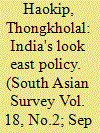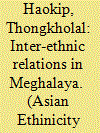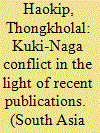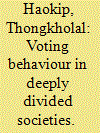| Srl | Item |
| 1 |
ID:
177558


|
|
|
|
|
| Summary/Abstract |
The outbreak of Covid-19 has been highly racialised and stigmatised around the world based on the origin of the virus and its highly infectious nature. Profiling of Asians or mongoloid looking individuals as a suspect carrier of the virus and the resultant taunts and discriminations occur worldwide. In India, the pandemic has reinforce racism against Northeast Indians, which the country has been grappling with this social problem in the last one decade or so. Such discriminations were overt acts of racial prejudice that primarily stems from the nonrecognition or misrecognition of Northeast Indians, who are mainly mongoloid race, as Indians. During the pandemic, the fight by Northeast Indians was with the mindset of the rest of Indians as much as the virus itself. It was a fight not only against the presumption of being ‘non-Indian’ with negative affiliation, or worse ‘unwanted Indians’, but also to get due recognition and acceptance as equal Indians. The absence of stringent anti-racism laws may have resulted in the pervasiveness of overt acts of racism during the pandemic. However, such actions are best understood on the structural elements that underpin Indian societies. The legal measures to address this social problem will reduce overt acts of racism but addressing covert racial acts, which are structural in nature, is a long way to go.
|
|
|
|
|
|
|
|
|
|
|
|
|
|
|
|
| 2 |
ID:
127682


|
|
|
|
|
| Publication |
2011.
|
| Summary/Abstract |
The Look East policy has emerged as an important foreign policy initiative of India in the post-Cold War period. It was launched in 1991 by the Narasimha Rao government with the aim of developing political contacts, increasing economic integration and forging security cooperation with countries of Southeast Asia. The policy marked a shift in India's perspective of the world, with the strategic and economic importance of Southeast Asia to India's national interests being recognised. The second phase, which began in 2003, extends the coverage of the Look East policy from Australia to East Asia, with Association of Southeast Asian Nations (ASEAN) as its core. The new phase thus marks a shift in focus from trade to wider economic and security cooperation, political partnerships, physical connectivity through road and rail links. In this article, the evolution of India's Look East policy and its recent approach are analysed.
|
|
|
|
|
|
|
|
|
|
|
|
|
|
|
|
| 3 |
ID:
131611


|
|
|
|
|
| Publication |
2014.
|
| Summary/Abstract |
The Indian state of Meghalaya, since its creation in 1972, had been raven by ethnic conflicts between the indigenous tribes and settler non-tribal communities. The domination of business establishments, labour force and other employment opportunities by settlers who are mainly economic migrants from Bangladesh, Nepal and other parts of India resulted in anxiousness among the native locals, resulting in three ethnic riots between indigenous tribals and settler non-tribal communities. By the turn of the twentieth century the state witnessed a relative change in the nature of relations between the ethnic communities. While the relations between the indigenous tribals and settler communities have relatively improved, ethnic tensions shifted to the indigenous tribes. This article uses the perceived threat hypothesis and a combination of rational choice theory and interpretivism to explain empirically observed realities in Meghalaya. Emphasis is placed on the post-1992 period, focusing on the emerging ethnic relations between the indigenous tribes of Meghalaya.
|
|
|
|
|
|
|
|
|
|
|
|
|
|
|
|
| 4 |
ID:
117929


|
|
|
|
|
| Publication |
2013.
|
| Summary/Abstract |
This brief article critically reviews various recent essays and publications on the Kuki-Naga conflict of the 1990s. The conflict has resulted in uprooting hundreds of villages, with the loss of more than a thousand lives, destruction of valuable properties and internal displacement. While British colonial policies of governance in Northeast India and the rise of ethnic nationalism among Kukis and Nagas in the post-independence period have been identified as major root causes of the Kuki-Naga conflict, the literature remains inconclusive and this article argues that today competing claims and perceived threats regarding land and territory appear to be the major cause of continuing tensions.
|
|
|
|
|
|
|
|
|
|
|
|
|
|
|
|
| 5 |
ID:
111287


|
|
|
|
|
| Publication |
2012.
|
| Summary/Abstract |
Most nation-states in Asia and Africa that gained independence from colonial rulers during the middle of the 20th century are diverse in their ethnic composition. The national governments make efforts to politically integrate their constituent units in the face of the continuing resistance of several ethnic groups. India adopted various means to integrate the more than 600 princely states and other loosely administered areas. Although the issue of integration has been largely settled in the mainland, various radical groups in the Northeastern region still question the extension of the Indian state. This article provides a historical analysis of the process of integration of the various states of Northeast India.
|
|
|
|
|
|
|
|
|
|
|
|
|
|
|
|
| 6 |
ID:
185496


|
|
|
|
|
| Summary/Abstract |
Voting patterns in the hills of Manipur show high ethnic voting indicating extremely partisan attachments. The salience of ethnicity in voting preference is reinforced by conflicts in the past. Periodic elections only exacerbated such divisions through partisan mobilisation and competition for representation along ethnic lines. Cross-ethnic voting is prevalent among groups wherein cousinage alliance cannot be forged due to past conflicts. The neck and neck competition for political representation among ethnic groups has sidelined the democratic rights of individuals over partisan group interests. In such deeply divided societies ensuring individual rights is the challenge of democratic governance, and the only viable solution to this pervasive problem appears to be a constitutional reform with the aim of having a more inclusive representation.
|
|
|
|
|
|
|
|
|
|
|
|
|
|
|
|